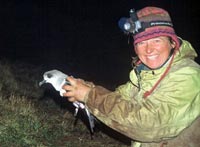Chile: Conservation in Action
Jo Smith

Chile, South America
My name is Jo Smith and I am a seabird biologist from Canada. I grew up on the east coast in Nova Scotia but migrated west to British Columbia after high school. I have two degrees from the University of Victoria: a Bachelor's of Science in Biology and Environmental Studies and a Masters of Science in Entomology. In 1995 I started a consulting business and have since worked on numerous conservation and education projects in both terrestrial and marine ecosystems. Four years ago I moved to Seattle, Washington to start a PhD at the University of Washington. For my dissertation, I study the Juan Fernández petrel (Pterodroma externa) on the Juan Fernández Islands, Chile.
The Juan Fernández Islands is a remote archipelago 670 km west from Santiago, Chile. Three spectacular islands, Robinson Crusoe, Santa Clara and Alejandro Selkirk, make up a 2.5 to 4 million-year-old volcanic island chain. The archipelago was declared a National Park in 1935 and a UNESCO Biosphere reserve in 1977. It is listed as one of the 12 most threatened national parks in the world because of the devastating effects of introduced species on the endemic plants and animals.
The only breeding location in the world for the Juan Fernández petrel is Isla Alejandro Selkirk, a 4,900 hectare island one full day’s travel by boat west of Robinson Crusoe. The island is remarkably rugged, with peaks rising steeply to 1,000 m above the sea. The petrels breed just once a year and nest underground in burrows along a 2 km ridge. These birds have quite an extreme existence! The parents incubate one egg for 55 days and then spend another 90 to 100 days feeding the chick. The adults return to their colony only at night and they bring back squid and fish to regurgitate to the hungry chick in the nest. I am studying the provisioning patterns and at-sea foraging locations of this species by collecting data at their nests and using very small data loggers attached to the birds. My PhD project will increase our understanding of the how the adults manage to feed themselves and their chicks over an extended breeding period of 150+ days, and where the adults go on their oceanic foraging trips.
Like many other petrels and endemic island species, the Juan Fernández petrel is listed as ‘Vulnerable’ by the World Conservation Union (IUCN – www.iucn.org). A census done in 1985 estimated that there were one million pairs, but cats and rats, introduced to the island, kill many birds each year. An additional concern for the adults is incidental mortality from longline fishing gear and the data I collect on their at-sea locations may help us better understand this potential problem.
What is most memorable moment or event in your career?
The most memorable event in my life as a seabird biologist was a 50-day voyage aboard a 13 m sailboat from the Galápagos Islands to British Columbia. After losing the ability to run our diesel engine four days into the ocean passage, two family friends and I sailed from the equator to 48° N, via a route that took us to 135° W. We recorded the name and position of all the birds along the route and afterwards, I and a colleague, David Hyrenbach, wrote a scientific paper detailing the marked change in the seabird community, from the warm, tropical equatorial waters to the cool, sub-arctic waters off British Columbia. As well, I recorded the presence of plastics and garbage and had first-hand observations of the surface debris with oceanographic phenomena, like convergence zones. It was a fantastic, life-changing experience.
Who has been a major inspiration to you?
Bernard Moitessier, a man that grew up in Indo-China in the 1960s and sailed alone around the world several times, inspired me at a young age to listen to my heart and follow my dreams. He also inspired me to try to live simply and trust others. In his books, he spoke of a simplicity and satisfaction in life that very few I’ve met successfully find.
In your opinion, what is the biggest challenge facing the world today?
I think the biggest challenge facing today’s population is denial. I read a great thing once about ‘seeing deniers’ and I often think about this with respect to the challenges we face today. Until people believe that we really need to do something quite different, or think of new ways to solve old problems, I feel that things won’t change very much. It seems to me that the reason we have so many ecological problems is not that people don’t recognize or acknowledge the problems, but rather they see them and yet still fail to act.
What message would you like to pass on to others and particularly young people considering a career in conservation?
To young people, I would say learn how to think critically and spend a lot of time outdoors with the species or ecosystems you love. Critical thinking is key to identifying the relevant or accurate information you find in books or journal articles but spending time outside will give you the deep understanding that you’ll need to come up with good research questions, design appropriate studies and interpret the data.
Find things to smile about because even though conservation can be hard work, life is very joyful. I really think it’s important to be with friends and family for support, and try to balance work with play. As Aldo Leopold suggested in one of his books, be a part time advocate. Work to save the mountains but spend time hiking in them too.
 Funded by TEK
Funded by TEK